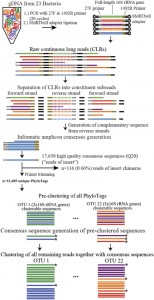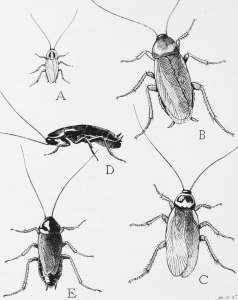An interesting new paper titled The Black Yeast Exophiala dermatitidis and Other Selected Opportunistic Human Fungal Pathogens Spread from Dishwashers to Kitchens came out several days ago in PLoS one. ZupanÄiÄ et al investigated the fungal diversity and distribution of 30 dishwashers. Swabs were taken from various parts in the dishwasher, sink, and on items that had been washed …
This seems like it could be of interest to microbial community researchers: The ISME Journal – High-resolution phylogenetic microbial community profiling Abstract (with bolding by me) Over the past decade, high-throughput short-read 16S rRNA gene amplicon sequencing has eclipsed clone-dependent long-read Sanger sequencing for microbial community profiling. The transition to new technologies has provided more …
A recent paper Dzieciol et al uses 16S pyrosequencing to characterize the bacterial biofilms on floor drains. Listeria monocytogenes was also tested for using both cuture-independent and -dependent techniques. Here is the abstract: Sanitation protocols are applied on a daily basis in food processing facilities to prevent the risk of cross-contamination with spoilage organisms. Floor drain water …
Happy Valentine’s Day! Here is a new post expressing my love for everything microbial and built. Based on real science and yes, there is chocolate. The great indoors Indoor microbial communities: Influence on asthma severity in atopic and nonatopic children – Karen C. Dannemiller – The Journal of Allergy and Clinical Immunology ($$) We sought …
Old photographs often are unique artifacts that provide a realistic look into the recent human history. However, many of these older printed photos are deteriorating, due to humidity, temperature, extended light exposure, and biodeterioration. Scientific Reports published a nice paper this week about the microbes found on and in old photographs, called Microbial communities affecting albumen photography heritage: …
As you all know, we are not alone in living in buildings. We have lots of things that live with us, some are invited guests like our pets and some we may or may not appreciate. Today I came across a lovely book by Richard Jones on insects that live in houses with us: House Guests, …
Your weekly update of the literature on microbes of the built environment sensu lato. Microbes in the house Rhinitis, Ocular, Throat and Dermal Symptoms, Headache and Tiredness among Students in Schools from Johor Bahru, Malaysia: Associations with Fungal DNA and Mycotoxins in Classroom Dust – Dan Norbäck – PLOS ONE (OA) There are few studies …
An oversight of the new papers that I found covering the intersection of humans, buildings, and microbes. Microbes in buildings Diversity of Bacterial Communities on Four Frequently Used Surfaces in a Large Brazilian Teaching Hospital – Tairacan Augusto Pereira da Fonseca – MDPI Int J Environ Res Public Health (OA) In this study, we aimed …
One of the most commonly quoted bits of information about the microbiome is that bacteria outnumber human cells 10 to 1. That figure has been widespread in media and promotional posters. It’s even on a a poster I got at ASM visualizing the basics of the human microbiome. But I have had a number of …
There is a new open access paper of possible interest to those working on water systems, green buildings, and/or microbial ecology: Survey of green building water systems reveals elevated water age and water quality concerns – Environmental Science: Water Research & Technology (RSC Publishing) DOI:10.1039/C5EW00221D By William J. Rhoads, Amy Pruden and Marc A. Edwards in Environmental …



